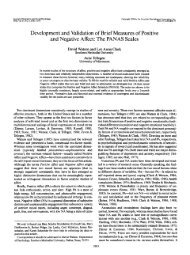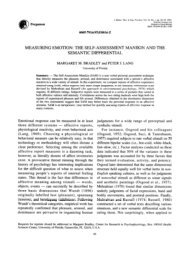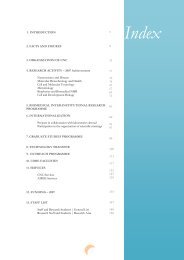Medical Mycology – Yeast Research | Head: Teresa GonçalvesObjectives1. With the final purpose <strong>of</strong> unravel the resistance<strong>of</strong> C<strong>and</strong>ida albicans to macrophage attack a studywas initiated with the aim to study the role <strong>of</strong>extracellular purines since ATP <strong>and</strong> its metabolite,adenosine, have been implicated in the immuneinflammatoryresponse as STOP signals.2. The increased number <strong>of</strong> yeast infectionsprompted us to study the epidemiology <strong>of</strong> yeastinfections in the Portuguese population attending aCentral Hospital.3. Our recent finding that the yeast Saccharomycescerevisiae responds to bacterial endotoxinactivating the HOG Signalling Pathway [J BiolChem 281: 24687‐24694(2006)] prompted us tostudy the impact <strong>of</strong> such activation in yeastmetabolism.4. With the identification in the dematiaceousfungus Alternaria infectoria <strong>of</strong> AiFKS <strong>and</strong> AiRHO,together with casp<strong>of</strong>ungin susceptibility, took us tostudy the combined effect <strong>of</strong> anti‐fungal cell wallinhibitors in collaboration with Pr<strong>of</strong> Neil Gow <strong>of</strong>the Institute <strong>of</strong> Medical Sciences, University <strong>of</strong>Aberdeeen, UK (manuscripts under preparation).Main Achievements1. Yeast metabolic response to the presence <strong>of</strong>bacterial endotoxin (one paper submitted)2. Combined effect <strong>of</strong> anti‐fungal cell wallinhibitors in A. infectoria: identification <strong>and</strong>cloning <strong>of</strong> the AiFKS gene <strong>and</strong> its regulatorAiRHO; casp<strong>of</strong>ungin susceptibility (2 papers underpreparation)3. Clinical mycology: a pathogenic yeast collectionwith 1000 isolates identified <strong>and</strong> characterisedusing molecular biology; an epidemiological study;a new diagnostic technology is being patented4. An in infection model using macrophage cellsinfected with C<strong>and</strong>ida albicans is currently beingused to study:a. the effect <strong>of</strong> purines <strong>and</strong> purinergic receptors inC. albicans clearance, indicating that adenosinemight affect this process trough specific adenosinereceptors (ongoing work)b. together with the Faculty <strong>of</strong> Medicine <strong>of</strong> Porto astudy was finished indicating that CUG ambiguityin C. albicans affects the phagocytic efficiency (onepaper under preparation)62Fig.1. a. C. albicans cell ingested by RAW264.7 macrophageb.,c. Yeast cells evading macrophage celld. Yeast cells inside the macrophage, <strong>for</strong>ming germ tubee. Yeast cell destroyed by phagolysosome
PublicationsAlarico S, da Costa MS, Empadinhas N (<strong>2008</strong>) Molecular <strong>and</strong> physiological role <strong>of</strong> the trehalosehydrolyzingalpha‐glucosidase from Thermus thermophilus HB27. J. Bacteriol. 190(7):2298‐305.Albuquerque L, Rainey FA, Nobre MF, da Costa MS (<strong>2008</strong>) Elioraea tepidiphila gen. nov., sp. nov., a slightlythermophilic member <strong>of</strong> the Alphaproteobacteria. Int. J. Syst. Evol. Microbiol. 58(Pt 4):773‐8.Albuquerque L, Tiago I, Taborda M, Nobre MF, Veríssimo A, da Costa MS (<strong>2008</strong>) Bacillus isabeliae sp. nov.,a halophilic bacterium isolated from a sea salt evaporation pond. Int. J. Syst. Evol. Microbiol. 58(Pt 1):226‐30.Alves M, Nogueira C, de Magalhães‐Santʹana A, Chung AP, Morais PV, da Costa MS (<strong>2008</strong>)Nosocomiicoccus ampullae gen. nov., sp. nov., isolated from the surface <strong>of</strong> bottles <strong>of</strong> saline solution used inwound cleansing. Int. J. Syst. Evol. Microbiol. 58(Pt 12):2939‐44.Antunes A, Rainey FA, Wanner G, Taborda M, Pätzold J, Nobre MF, da Costa MS, Huber R (<strong>2008</strong>) A newlineage <strong>of</strong> halophilic, wall‐less, contractile bacteria from a brine‐filled deep <strong>of</strong> the Red Sea. J. Bacteriol.190(10):3580‐7.Antunes A, Taborda M, Huber R, Moissl C, Nobre MF, da Costa MS (<strong>2008</strong>) Halorhabdus tiamatea sp. nov., anon‐pigmented, extremely halophilic archaeon from a deep‐sea, hypersaline anoxic basin <strong>of</strong> the Red Sea,<strong>and</strong> emended description <strong>of</strong> the genus Halorhabdus. Int. J. Syst. Evol. Microbiol. 58(Pt 1):215‐20.Callegan RP, Nobre MF, McTernan PM, Battista JR, Navarro‐González R, McKay CP, da Costa MS, RaineyFA (<strong>2008</strong>) Description <strong>of</strong> four novel psychrophilic, ionizing radiation‐sensitive Deinococcus species fromalpine environments. Int. J. Syst. Evol. Microbiol. 58(Pt 5):1252‐8.Cava F, Zafra O, da Costa MS, Berenguer J (<strong>2008</strong>) The role <strong>of</strong> the nitrate respiration element <strong>of</strong> Thermusthermophilus in the control <strong>and</strong> activity <strong>of</strong> the denitrification apparatus. Environ. Microbiol. 10(2):522‐33.Empadinhas N, Albuquerque L, Mendes V, Macedo‐Ribeiro S, da Costa MS (<strong>2008</strong>) Identification <strong>of</strong> themycobacterial glucosyl‐3‐phosphoglycerate synthase. FEMS Microbiol. Lett. 280(2):195‐202.63Empadinhas N, da Costa MS. <strong>2008</strong>. Osmoadaptation mechanisms in prokaryotes: distribution <strong>of</strong>compatible solutes. Int Microbiol. 11(3):151‐61.Empadinhas N, da Costa MS (<strong>2008</strong>) To be or not to be a compatible solute: bioversatility <strong>of</strong>mannosylglycerate <strong>and</strong> glucosylglycerate. Syst. Appl. Microbiol. 31(3):159‐68.Hipolito E, Faria E, Alves AF, de Hoog GS, Anjos J, Gonçalves T, Morais PV, Estevão H (<strong>2008</strong>) Alternariainfectoria brain abscess in a child with chronic granulomatous disease. Eur. J. Clin Microbiol Infect. Dis. 28:377‐380.Nobre A, Alarico S, Fern<strong>and</strong>es C, Empadinhas N, da Costa MS (<strong>2008</strong>) A unique combination <strong>of</strong> geneticsystems <strong>for</strong> the synthesis <strong>of</strong> trehalose in Rubrobacter xylanophilus: properties <strong>of</strong> a rare actinobacterialTreT. J. Bacteriol. 190(24):7939‐46.Paulo C, Mourão C, Veiga PM, Marques JM, Rocha G, Alves AF; Querol A, Meliço‐Silvestre AA,Gonçalves I, Flores, ClementeC, Gonçalves T (<strong>2008</strong>) Retrospective analysis <strong>of</strong> clinical yeast isolates in ahospital in the centre <strong>of</strong> Portugal: spectrum <strong>and</strong> revision <strong>of</strong> the identification procedures. Med. Mycol. DOI:10.1080/13693780802709081.Pereira PJ, Empadinhas N, Albuquerque L, Sá‐Moura B, da Costa MS, Macedo‐Ribeiro S (<strong>2008</strong>)Mycobacterium tuberculosis glucosyl‐3‐phosphoglycerate synthase: structure <strong>of</strong> a key enzyme inmethylglucose lipopolysaccharide biosynthesis. PLoS ONE 3(11):e3748.Sá‐Moura B, Albuquerque L, Empadinhas N, da Costa MS, Pereira PJ, Macedo‐Ribeiro S (<strong>2008</strong>)Crystallization <strong>and</strong> preliminary crystallographic analysis <strong>of</strong> mannosyl‐3‐phosphoglycerate synthasefromRubrobacter xylanophilus. Acta Crystallogr. Sec.t F. Struct. Biol. Cryst. Commun. 1;64(Pt 8):760‐3.
- Page 7 and 8:
General ObjectivesThe CNC major mis
- Page 11 and 12: OrganizationThe Center for Neurosci
- Page 13: Microbiology | Milton CostaMicrobio
- Page 16 and 17: per year) will be proposed by the g
- Page 18 and 19: Neuroprotection and Neurogenesis in
- Page 20 and 21: Retinal Dysfunction and Neurogenesi
- Page 22 and 23: Glutamatergic synapses | Head: Ana
- Page 24 and 25: Neuronal Cell Death and Neuroprotec
- Page 26 and 27: Molecular Mechanisms of Disease | H
- Page 28 and 29: PublicationsAgasse F, Bernardino L,
- Page 30 and 31: Santiago AR, Carvalho, CM, Carvalho
- Page 32 and 33: “Nano‐transportadores de base l
- Page 34 and 35: Vectors and Gene Therapy GroupM. Co
- Page 36 and 37: Molecular Systems Biology | Head: A
- Page 38 and 39: Vectors and Gene Therapy | Head: Ma
- Page 40 and 41: PublicationsAlves S, Nascimento‐F
- Page 43 and 44: Area C | Cell and Molecular Toxicol
- Page 45 and 46: Mitochondrial Toxicology and Pharma
- Page 47: Pharmacometrics GroupAmílcar Falc
- Page 50 and 51: Free Radicals and Antioxidants in B
- Page 52 and 53: Pharmacometrics | Head: Amílcar Fa
- Page 54 and 55: Correia S, Carvalho C, Santos MS, P
- Page 57 and 58: Area D | MicrobiologyCoordinator |
- Page 59: Microbiology of Extreme Environment
- Page 65 and 66: Area E | Biophysics and Biomedical
- Page 67 and 68: Inorganic Biochemistry and Molecula
- Page 69 and 70: Inorganic Biochemistry and Molecula
- Page 71 and 72: Cell Biophysics |Head: Luís Martin
- Page 73: Sobral AJFN, Justino LLG, Santos AC
- Page 76 and 77: Future PlansThere is an enormous we
- Page 78 and 79: Paula MotaSara M. Diniz Martins Lop
- Page 80 and 81: Biology of Reproduction and Human F
- Page 82 and 83: Insulin Resistance and Adipocyte |
- Page 85 and 86: Biomedical Inter‐Institutional Re
- Page 87 and 88: 3. Pediatric Research: metabolic di
- Page 89 and 90: PublicationsSantos MJ, Cleto S, Men
- Page 91: 7. Research in brain cancer: geneti
- Page 94 and 95: Grafting SVZ neural stem cell cultu
- Page 96 and 97: Structure‐function analysis of th
- Page 98 and 99: Anticancer Effects of of Phytochemi
- Page 100 and 101: Investigaciones Biomédicas “Albe
- Page 102 and 103: Participation in the organization o
- Page 104 and 105: May 2008Member of the organizing co
- Page 106 and 107: 106
- Page 108 and 109: Genome BiologyFebruary 25 ‐ 27Isa
- Page 110 and 111: Seminars2008 Series | CNC Audithori
- Page 112 and 113:
13.6.2008Cells caught in the act: M
- Page 114 and 115:
5.12.2008Unexpected fate and functi
- Page 116 and 117:
Elisabete Ferreiro“Cross‐talk b
- Page 118 and 119:
Ana Isabel Vicente Rafael“Estudos
- Page 120 and 121:
Rosete Pais“Papilomavirus humano
- Page 122 and 123:
122
- Page 124 and 125:
124
- Page 126 and 127:
FLOW CYTOMETRY UNITHead of Unit: Is
- Page 128 and 129:
MASS SPECTROMETRY UNITHead of Unit:
- Page 130 and 131:
130
- Page 132 and 133:
Amino Acid AnalysisOur laboratory r
- Page 134 and 135:
2. Areas of Expertise / Research /
- Page 136 and 137:
Multiple SclerosisAn extension of t
- Page 138 and 139:
2.2. Centre for Bioavailability Stu
- Page 140 and 141:
StaffCoordinatorTice Macedo, MD, Ph
- Page 142 and 143:
142
- Page 144 and 145:
Compatible solutes from extremophil
- Page 146 and 147:
Proteases aspárticas secretadas em
- Page 148 and 149:
Mecanismos de plasticidade sinápti
- Page 150 and 151:
Clivagem dos transportadores vesicu
- Page 152 and 153:
ʺBIOINK ‐ Aprendizagem increment
- Page 154 and 155:
154
- Page 156 and 157:
Henrique Faneca (Auxiliar Inv., CNC
- Page 158 and 159:
Liliana Bernardino 100Luis Miguel E
- Page 160 and 161:
João Teixeira 100João Teodoro 100
- Page 162 and 163:
Patricia Henriques Domingues 100Pat
- Page 164 and 165:
ADMINISTRATIVE STAFFTime % at CNCAr
- Page 166 and 167:
Sandra Isabel M. Cardoso (Auxiliar
- Page 168 and 169:
Molecular Biotechnology and HealthE
- Page 170 and 171:
Cell and Molecular ToxicologyLeonor
- Page 172 and 173:
MicrobiologyMilton Costa, PhD, Coor
- Page 174 and 175:
Paulo Gameiro Guerreiro 100Pedro Co
- Page 176 and 177:
Marta Isabel Rodrigues Baptista 100
- Page 178:
Url: http://www.cnbc.pt | Email: in






